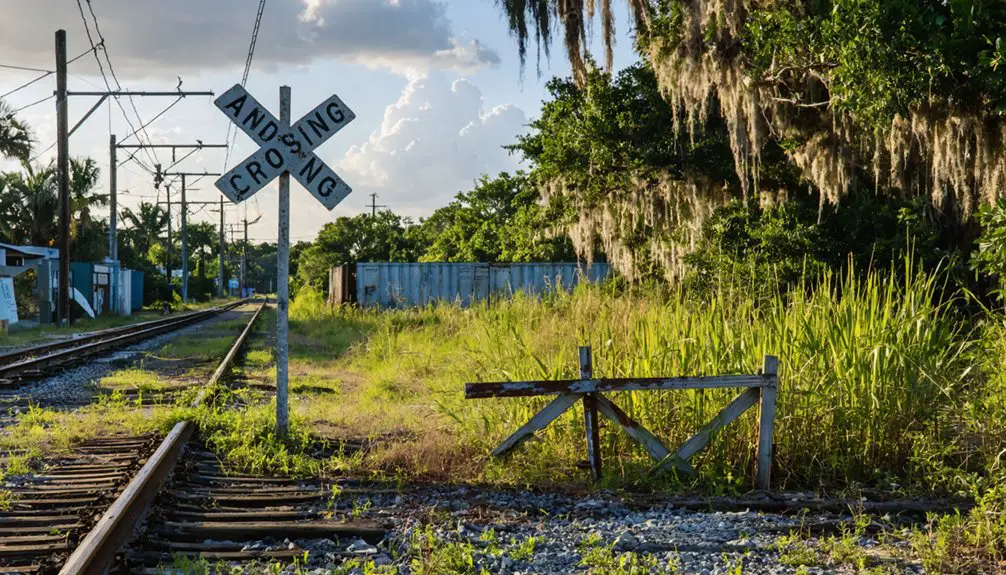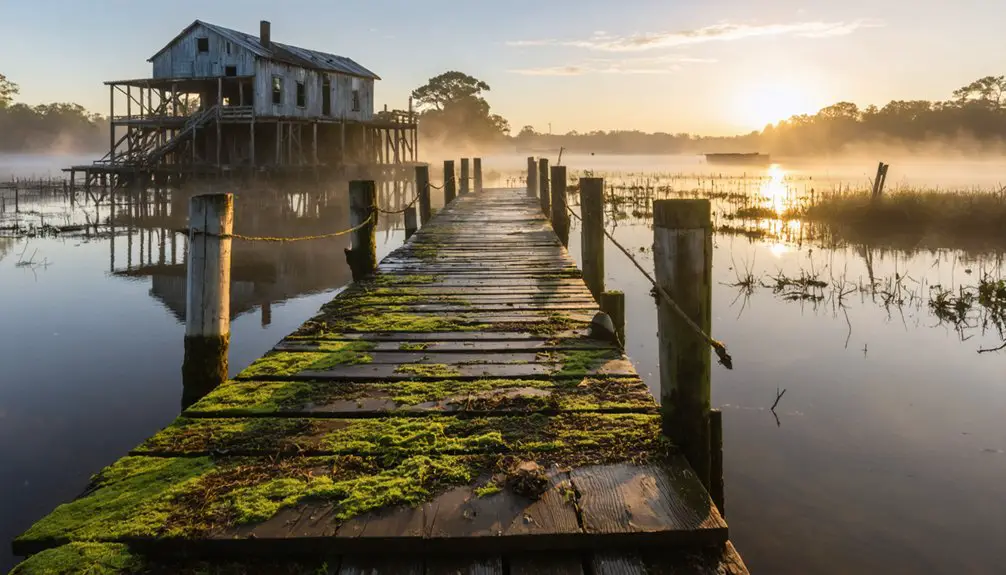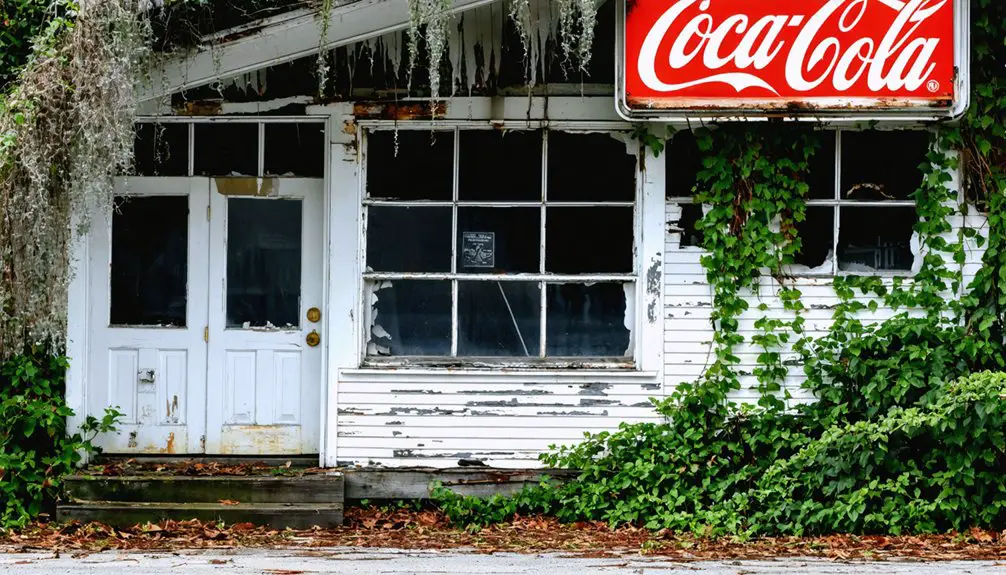You’ll find Anona, Florida tucked away in modern-day Largo, where it once thrived as a bustling coastal trading post in the 1870s. Captain John Thomas Lowe established this strategic settlement along The Narrows waterway between Cedar Key and Key West, developing it with a church, school, and essential maritime trade routes. While the removal of the railroad bridge in 1928 led to Anona’s decline, its rich heritage lives on through preserved landmarks and the historic Anona Cemetery.
Key Takeaways
- Anona was established in the 1870s near Lowe’s Landing on Florida’s Gulf Coast but eventually faded into obscurity.
- The removal of the railroad bridge in 1928 severed crucial transportation links, contributing to Anona’s decline.
- The once-thriving port town was ultimately absorbed into the city of Largo, losing its independent identity.
- Historic remnants include the 1872 Anona United Methodist Church, pioneer structures, and the Anona Cemetery.
- Pellis County Heritage Park now preserves Anona’s history, featuring the 1900 schoolhouse and other historical landmarks.
The Birth of a Coastal Trading Post
While many Florida coastal settlements emerged following the Civil War, Anona established itself as an essential trading post in the 1870s near Lowe’s Landing on the Gulf Coast.
You’ll find its strategic coastal geography along The Narrows waterway made it a perfect stopover between Cedar Key and Key West.
Captain John T. Lowe, one of the area’s early settlers, built a clapboard house and general store that became the heart of this growing community.
The settlement took its name from the sugar apple trees (Annona) that flourished in the region, brought north from Key West.
As more pioneers arrived, the trading post expanded southward along Indian Rocks Road, transforming from a simple mail distribution point into a bustling hub of maritime commerce. The area’s earliest residents constructed primitive wooden cabins that served as the foundation for the developing settlement.
Legacy of Captain John Thomas Lowe
You’ll find Captain John Thomas Lowe‘s enduring mark on Anona through his establishment of essential maritime trade routes and his visionary town planning that included donating land for the community’s first church and school in 1874.
His seafaring expertise as a blockade runner during the Civil War and later as commander of mail-carrying schooners like the Sea Drift showcased his crucial role in connecting Florida’s Gulf Coast communities. These endeavors are well documented in historical records today.
The arrival of the Orange Belt Railroad in 1888 further enhanced the economic opportunities established by Lowe’s early maritime ventures. The Lowe family’s influence extended well into the 20th century, with their home serving as a social hub and their agricultural ventures, including citrus groves and Wesley Lowe’s 1911 barn, shaping Anona’s development.
Maritime Trade Pioneer
As Florida’s maritime trade routes expanded in the late 19th century, Captain John Thomas Lowe emerged as a pivotal figure in connecting the region’s coastal communities.
You’ll find his maritime innovations shaped the development of Key West and surrounding ports through his fleet of schooners and sponging sloops, supported by strategically placed lumberyards and repair facilities. His family later sold their ships to spongers in Tarpon Springs during the early 1890s.
From his early days learning navigation alongside his father William, Lowe built a coastal commerce network that proved crucial to Florida’s growth.
He’d transport essential mail, lumber, and provisions between Key West and Cedar Keys, even extending trade to New Orleans and Honduras. Like his relative Edward R. Lowe who would later become a prominent figure, he arrived in the Keys as a post-Spanish-American War settler.
His marine railways and waterfront facilities revolutionized vessel maintenance, while his reliable mail service united isolated settlements along Florida’s west coast before roads existed.
Lowe’s Town Planning Vision
Through his methodical town planning initiatives in the late 1850s, Captain John Thomas Lowe transformed a simple landing site into the thriving community of Anona. His vision for community infrastructure centered on creating a self-sustaining settlement where you’d find everything needed for pioneer life.
Key elements of Lowe’s settlement sustainability plan included:
- Establishing essential services with a general store and post office
- Donating land for religious and educational facilities, including the Anona Church and cemetery
- Developing agricultural operations like citrus groves to guarantee economic stability
You’ll recognize Lowe’s legacy in the strategic placement of facilities that fostered community growth southward from Lowe’s Landing, the original nucleus of what would become a distinctive Florida settlement along the Intracoastal Waterway.
Family Legacy in Anona
Building upon Lowe’s town planning achievements, the family’s influence on Anona extended far beyond its initial settlement.
You’ll find their legacy deeply woven into the community’s fabric through the establishment of citrus groves, farms, and essential infrastructure. Captain Lowe’s family contributions included donating land for Anona’s first church and school in 1874, while his clapboard home and general store became cornerstones of local commerce.
Wesley Lowe’s homestead served as a cherished gathering place for pioneer families until the 1930s.
The family’s commitment to community development manifested through Jefferson Lowe’s role as the first postmaster in 1883, and their expanding agricultural operations supported the area’s growing needs.
Even today, preserved family structures in Heritage Village stand as a testament to their enduring impact on Anona’s identity.
Religious and Educational Foundations
When local residents constructed Anona’s first church in 1872, they established what would become the town’s spiritual and educational cornerstone.
Under Rev. John Wells’ leadership, the church community flourished, with the building serving dual purposes as both a place of worship and a schoolhouse. For clarity and historical accuracy, the church location serves as a disambiguation point for various Anona references.
The vibrant railroad system helped transport residents to church and school services in the late 1800s, connecting the growing community.
You’ll find three key developments that shaped Anona’s religious and educational evolution:
- Captain John Thomas Lowe’s donation of two acres for church and burial grounds
- The 1882 construction of a second church building, which still stands today
- The establishment of a dedicated school building by 1900, marking educational progress
The Anona United Methodist Church, alongside its cemetery, remains a preserved memorial to the town’s heritage at Pinellas County Heritage Park, where you can still visit these historic landmarks.
Transportation Hub and Economic Growth

As transportation networks expanded across Florida in the late 1800s, Anona emerged as an important hub linking sea and rail commerce.
You’d find Captain John Lowe’s schooners carrying mail and freight along the Gulf Coast’s shipping routes from Cedar Key to Key West, while a significant railroad spur crossed the island, connecting local markets to broader regional trade. The area was once a major industrial center with various thriving businesses supporting the rail line. Like the early Seminoles who used dugout cypress canoes for trading, the waterways remained vital to local commerce.
The railroad’s impact transformed Anona’s economy, enabling efficient transport of agricultural products and merchandise.
In 1916, you could cross the new toll bridge for 25 cents, marking the rise of automotive transport. The general store, doubling as a post office, became the heart of local commerce.
However, when the railroad bridge’s removal in 1928 severed critical transport links, Anona’s prominence began to fade, eventually leading to its absorption into Largo.
Historical Landmarks and Preserved Heritage
Today, you’ll find Anona’s rich heritage carefully preserved within Pellis County Heritage Park, where several historic landmarks tell the story of this once-thriving community.
The park’s landmark preservation efforts showcase authentic pioneer structures, including the iconic LWH House and the 1900 schoolhouse, offering glimpses into 19th-century Florida life. Local artisans demonstrate traditional crafts like making pillows from Spanish moss here.
- The Anona United Methodist Church, built in 1872, stands as a representation of the community’s spiritual foundation, with its original chapel still intact.
- The historic Anona Cemetery provides invaluable genealogical records of the town’s earliest settlers.
- Railroad remnants highlight the historical significance of transportation in shaping the town’s destiny.
These preserved sites now serve as living classrooms, where you can experience the authentic architectural features and cultural elements that defined this pioneering community.
From Thriving Port to Modern Memory

Beyond the preserved landmarks, Anona’s remarkable change from bustling port to quiet memory began with Captain John Thomas Lowe‘s establishment of a landing site in 1883.
You’ll find that his schooner Sea Drift once connected this crucial port to maritime routes between Cedar Keys and Key West, while a railroad spur facilitated inland trade.
The cultural evolution of Anona mirrors Florida’s changing landscape. When the railroad bridge came down in 1928, you could witness the economic shift from maritime hub to residential community.
What was once a thriving port town, complete with general stores and a bustling post office, gradually merged into Largo’s expanding borders.
The agricultural legacy of citrus groves and farmsteads sustained the community until suburban development reshaped the coastal area.
Frequently Asked Questions
What Happened to the Original Residents of Anona After Its Decline?
You’ll find displacement stories showing residents moved mainly to nearby Largo, while others followed maritime trade routes. They’ve preserved their historical legacy through landmarks like Anona Church and relocated cemeteries.
Are There Any Surviving Photographs of Anona During Its Prime Years?
Like footprints washed away by time, you won’t find photographs of Anona’s prime in historical archives. No verified photographic evidence has survived, though local collections might hold undiscovered treasures.
What Was the Population of Anona at Its Peak?
While studying Anona’s history as a ghost town, you’ll find no exact peak population records exist, but based on similar Florida settlements from that era, it likely had between 100-300 residents.
How Much Was the Toll for Crossing the Bridge in 1916?
Like a steady heartbeat of commerce, you’d pay 25 cents per crossing on the Anona Bridge in 1916, whether walking or driving – a toll rate that carried historical significance for the community’s connection.
When Was the Last Time Anona Operated as an Independent Community?
You’ll find that Anona’s ghost town history marks its last independent operations in the early 20th century, with community decline accelerating after 1928 when they removed the crucial transport bridge.
References
- https://en.wikipedia.org/wiki/Anona
- https://www.tampabay.com/archive/1996/08/22/before-beaches-were-settled-cabins-rose-at-anona/
- https://www.narcity.com/miami/17-abandoned-ghost-towns-you-must-visit-in-florida
- https://www.pinterest.com/pin/270356783855672424/
- https://www.youtube.com/watch?v=HLXzZV7zRv8
- https://digitalcommons.usf.edu/cgi/viewcontent.cgi?article=4023&context=fac_publications
- https://www.boem.gov/sites/default/files/documents/regions/gulf-mexico-ocs-region/office-environment/TR-BOEM-2021-057.pdf
- https://en.wikipedia.org/wiki/Timeline_of_Largo
- https://grahamsegger.com/florida-focus/burnt-store-marina-blog-pre-2020/new-management-revitalizes-the-trading-post/
- https://digitalcommons.usf.edu/cgi/viewcontent.cgi?filename=5&article=4026&context=fac_publications&type=additional



